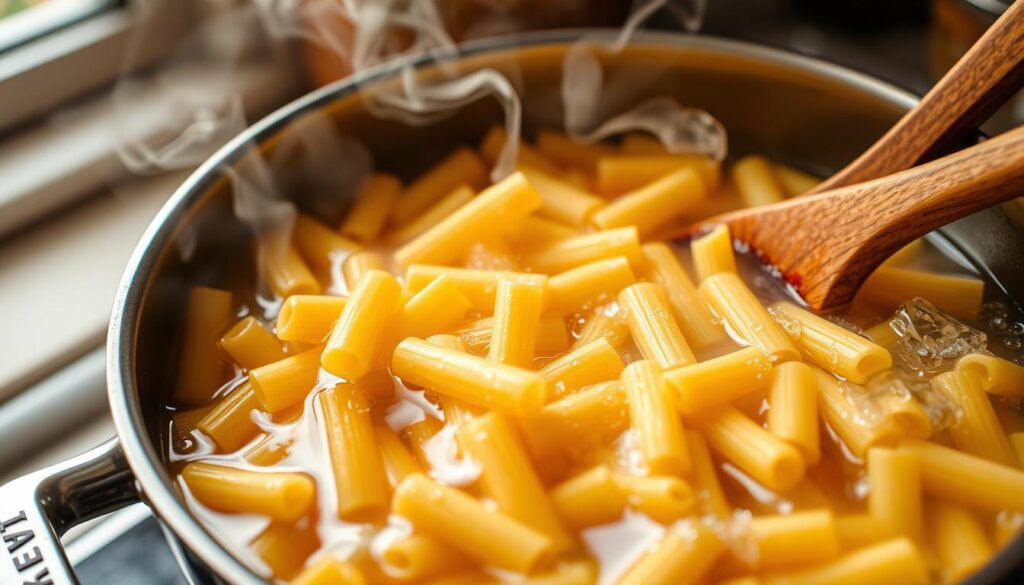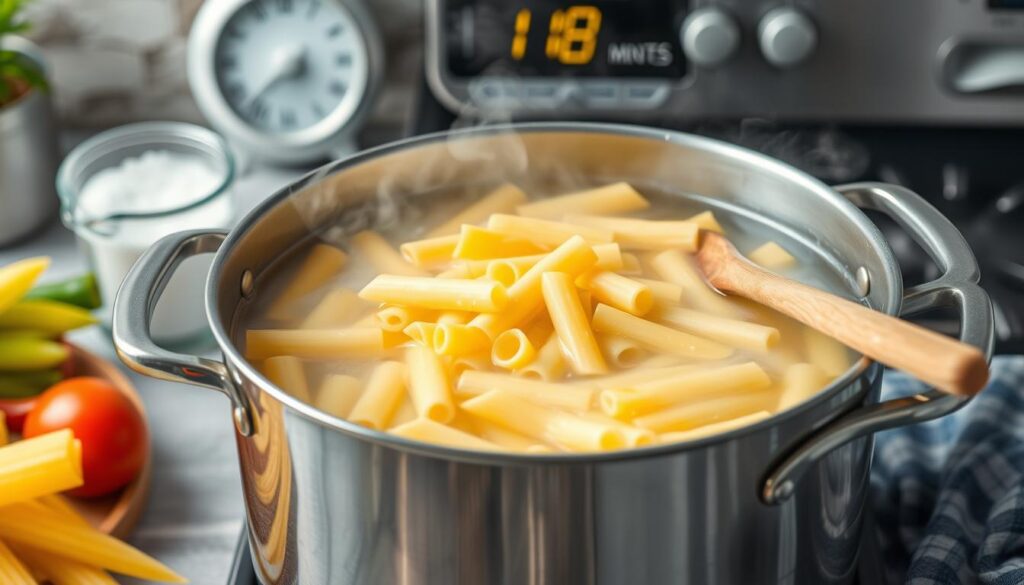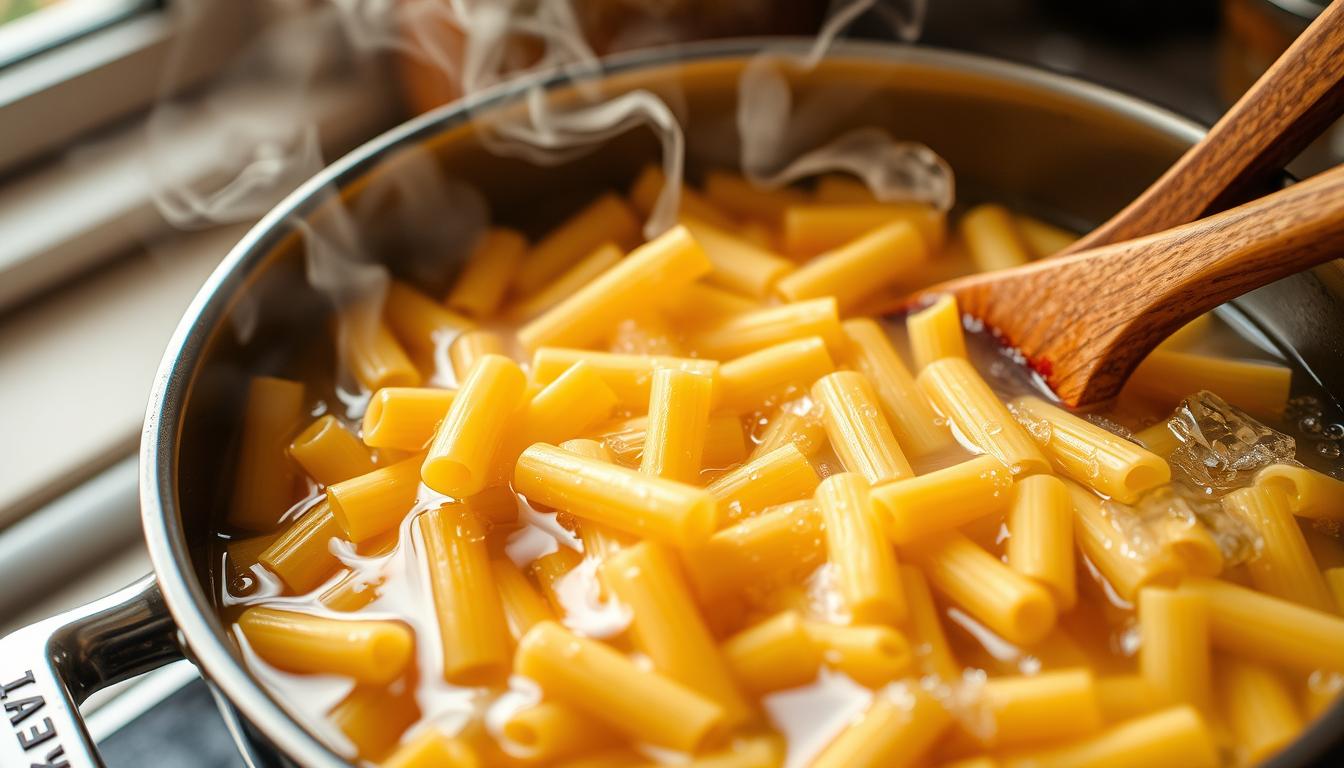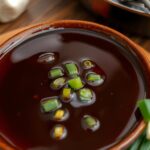Rigatoni pasta is a beloved part of Italian cuisine. It’s known for its unique shape and texture. This makes it a top pick for many who love sauces.
- Understanding Al Dente Pasta
- The Right Cooking Time for Rigatoni
- How Long to Cook Rigatoni Pasta Al Dente?
- Essential Ingredients for Cooking Rigatoni
- Equipment You Need to Cook Rigatoni Perfectly
- Mastering the Art of Boiling Rigatoni
- Delicious Sauce Pairings for Rigatoni
- Common Mistakes to Avoid When Cooking Rigatoni
- Conclusion

To get the perfect texture, you need to know how long to cook it. Unlike thin pastas, rigatoni takes about 12 to 14 minutes to cook al dente. Al dente means it should have a firm bite.
This article will guide you through boiling rigatoni. You’ll learn how to cook it just right and keep it al dente. You’ll also discover how to pair it with different sauces. This will help you improve your rigatoni dishes in the kitchen.
Understanding Al Dente Pasta
The term al dente is key in pasta cooking. It means the pasta is firm but not hard to bite. This texture keeps the pasta’s flavor and prevents it from getting mushy.
What Does Al Dente Mean?
Cooking pasta to al dente is all about timing. Most pasta takes about 10 minutes to cook. But shapes like bows or penne might need 10 to 12 minutes. Fresh pasta, like ravioli, cooks in just 3 to 5 minutes.
Knowing how long to cook different pasta types is vital. To check if pasta is al dente, bite into it. It should be tender but have some chew.
The Importance of Al Dente in Italian Cuisine
In Italian cooking, serving pasta al dente is very important. This texture makes each dish better and follows pasta traditions. For example, rigatoni needs 12 to 14 minutes to be just right.
This focus on culinary techniques makes meals rich in flavor and texture. It makes home cooking special.
The Right Cooking Time for Rigatoni
Getting the perfect texture for rigatoni is all about knowing the right cooking time. It’s also about understanding how different factors can change this time. This knowledge is key for anyone who loves pasta.
Typical Cooking Time for Rigatoni
The usual rigatoni cooking duration is between 12 to 14 minutes. This is when it reaches the perfect al dente state. It’s important to watch this time closely.
Taste a piece of pasta around the 8-minute mark. This helps you adjust based on the pasta’s quality. It prevents it from getting overcooked.
Factors Affecting Boiling Time
Several things can change how long it takes to boil rigatoni, including:
- Pasta Quality: Better pasta, like bronze-cut, keeps its texture better than cheap pasta.
- Water Temperature: Starting with boiling water helps cook pasta evenly and quickly.
- Altitude Effects: At higher elevations, pasta may need to cook longer because of lower air pressure.
For cooking, use about 4-6 quarts of water for every pound of pasta. This gives the pasta enough room to cook without sticking. Adding salt, about 1-2 tablespoons per gallon of water, improves flavor and helps the sauce stick better.
| Factor | Impact on Cooking Time |
|---|---|
| Pasta Quality | Better texture retention, less prone to overcooking. |
| Water Temperature | Faster cooking time with consistently boiling water. |
| Altitude Effects | Longer cooking time may be needed at higher elevations. |
By knowing these important points, anyone can cook rigatoni perfectly. This ensures every meal is delicious and satisfying.
How Long to Cook Rigatoni Pasta Al Dente?
Getting the perfect al dente texture in rigatoni takes focus on the boiling and timing. Knowing the steps can make your pasta prep and meal better. Follow this guide to make sure your rigatoni is always just right.
Boiling Rigatoni: A Step-by-Step Guide
Start by measuring 300g of rigatoni for four people, about 75g each. Use a big pot with at least 3 liters of water. Add a big spoonful of sea salt to the water for extra flavor.
Heat the water to a strong boil before adding the rigatoni. Stir the pasta a few times while it cooks to prevent sticking. Check if it’s done around the 8-minute mark. Rigatoni usually needs 2-3 minutes less than the package says for al dente.
When the pasta is almost done, save about ¼ cup of the cooking water. This water is key for mixing your sauce later. Drain the rigatoni carefully without rinsing. This keeps the starch that helps sauces stick to the pasta. Then, toss the cooked rigatoni with your favorite sauce for the best taste.
Essential Ingredients for Cooking Rigatoni
When cooking rigatoni, choosing the right ingredients is key. Quality pasta is vital for the dish’s texture and taste. There are many types of rigatoni, each with its own cooking time and sauce pairing.
Knowing which rigatoni to pick can make your pasta dish stand out.
Choosing the Best Rigatoni
Choosing high-quality rigatoni can greatly improve your meal. Look for brands made from durum wheat with a bronze-cut finish. This finish helps sauces stick better, making each bite more flavorful.
Brands like DeLallo are known for their excellent rigatoni. They offer a range of styles, such as mezzi rigatoni and ziti, each adding its own twist to your dish.
The Role of Salt in Cooking Pasta
Salting pasta water is a must for better flavor. Use about 1-2 tablespoons of salt for every 4 quarts of boiling water. This step not only adds flavor but also improves the pasta’s texture.
By salting correctly, each piece of rigatoni absorbs the seasoning. This creates a balanced taste that pairs well with your sauce.
Equipment You Need to Cook Rigatoni Perfectly
To cook perfect rigatoni, you need the right kitchen tools. A well-organized kitchen makes cooking fun and helps your meal turn out great. The right tools not only help cook the pasta but also make it taste and feel better.
Choosing the Right Pot
Choosing the best pot for pasta is key. A big pot lets the pasta move freely, preventing it from sticking. Fill the pot two-thirds full with water for the best boil. For rigatoni, a pot that holds 4-5 quarts is best to cook a full pound.
Must-Have Kitchen Tools for Cooking Pasta
Some kitchen tools make cooking pasta easier. Here are a few you should have:
- Colander uses: It’s essential for draining pasta after cooking. It lets you remove water quickly while keeping the rigatoni.
- Wooden spoon: Great for stirring without scratching your pot.
- Measuring cup: It helps you measure water and salt accurately, which is key to cooking pasta right.
Investing in these kitchen essentials makes cooking rigatoni efficient and fun. These tools play a big role in making your pasta dish perfect every time.
Mastering the Art of Boiling Rigatoni
Boiling rigatoni right means knowing the water-to-pasta ratio and using the best stirring and timing methods. Getting the perfect al dente texture depends on the right water, salt, and watching the cooking closely.
Water-to-Pasta Ratio
For every pound of rigatoni, use 4-6 quarts of water. This amount ensures even cooking and prevents sticking. Adding 1 tablespoon of kosher salt per quart of water also boosts the pasta’s flavor.
Stirring and Timing Techniques
Good cooking starts with stirring the pasta well in the beginning to avoid clumps. It’s also key to check the pasta’s texture by tasting it a few minutes before the package suggests. Rigatoni usually needs 11-13 minutes to cook just right.

Delicious Sauce Pairings for Rigatoni
Rigatoni pairs well with many sauces, making it a favorite in traditional pasta dishes. It goes great with Bolognese and creamy Alfredo, among others. This shows how well it absorbs flavors, making meals enjoyable.
Classic Sauces to Try with Rigatoni
Several classic sauces stand out with rigatoni. Here are a few:
- Bolognese Sauce: A meaty sauce that complements the pasta’s texture.
- Marinara: A simple tomato sauce with herbs and garlic.
- Alfredo: Creamy and rich, perfect for a satisfying meal.
- Vodka Sauce: A mix of tomato, cream, and spirits for a unique taste.
Each sauce brings out different qualities of rigatoni, showing how versatile it is.
Creative Rigatoni Dishes to Experiment With
Trying new rigatoni recipes can boost your cooking skills. For example:
- Baked Rigatoni with Cheese: A comforting dish with layers of cheese and sauce.
- Rigatoni alla Vodka: A zesty mix of creaminess and tang for a memorable taste.
- Vegetable Rigatoni: Add seasonal veggies like butternut squash for a fresh twist.
Using ingredients like Italian sausage, ricotta, and herbs lets you get creative. These dishes not only look good but also offer exciting flavors and textures. They make pasta a delightful experience for everyone.
Common Mistakes to Avoid When Cooking Rigatoni
Whether you’re new to cooking or have years of experience, mistakes can happen. These mistakes can ruin a dish that should be perfect. Knowing what to avoid can make your pasta dish better and more enjoyable.
Overcooking and Rinsing Pasta
One big mistake is overcooking rigatoni. This makes the pasta mushy, losing its *al dente* texture and taste. Always follow the cooking times on the package. If you plan to bake it later, cut down the cooking time a bit.
Another mistake is rinsing the pasta after cooking. Rinsing takes away the starch that helps sauces stick to the pasta. This makes your meal less flavorful.
Using too Little Water
Not using enough water can also mess up your pasta. Use one liter of water for every 100 grams of rigatoni. If you don’t, the pasta will clump and stick together, making it hard to cook evenly.
Getting the water measurement right is key. It keeps the pasta’s texture and flavor just right.

Conclusion
Cooking rigatoni is all about finding the right balance. It’s important to pick quality ingredients and know the perfect cooking time. Tips like using less water and stirring often can make a big difference.
Research shows that you don’t need a lot of boiling water to cook pasta. Using smaller pots can actually improve the texture and quality. Trying different pot sizes can lead to new and exciting ways of cooking.
The fun of cooking rigatoni is making it your own. You can choose from classic sauces or try new recipes. By following these tips, you’ll get better at making delicious pasta. Enjoy every step of your pasta-making journey.









